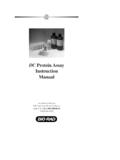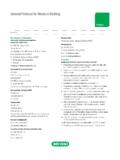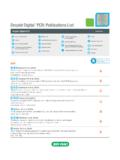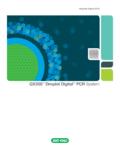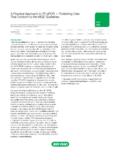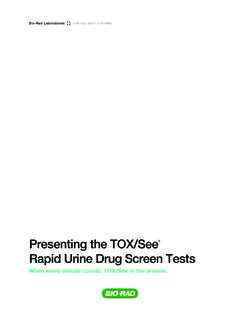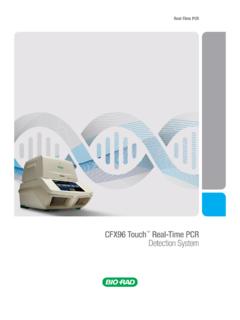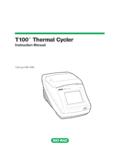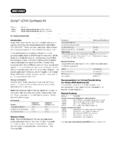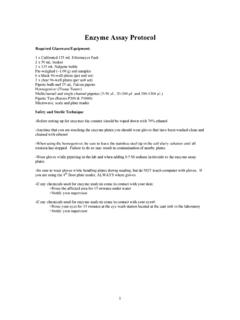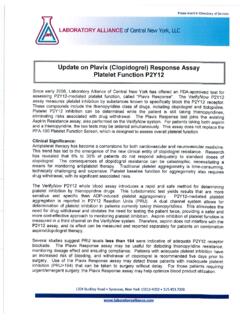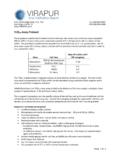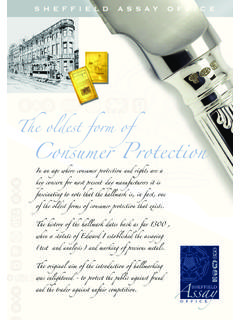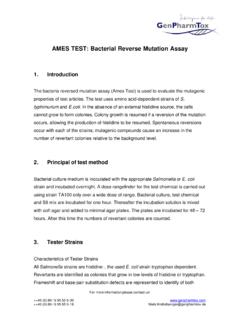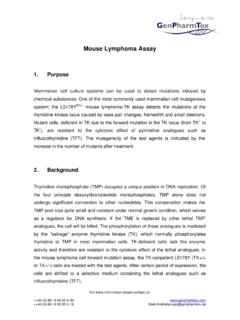Transcription of 1-800-4BIORAD Protein Assay Bio-Rad
1 LIT33C 8/31/98 02:25 PM Page a Bio-Rad Protein Assay For Technical Service Call Your Local Bio-Rad Office or in the Call 1-800-4 BIORAD. (1-800-424-6723). LIT33C 8/31/98 02:25 PM Page b Table of Contents Section 1 1. Principle .. 1. Product 3. Materials Required but Not 3. Section 2 4. Reconstituting the Standard .. 4. Standard Procedure .. 4. Microassay Procedure .. 5. Microtiter Plate Protocols .. 6. Section 3 Common 8. Section 4 Troubleshooting Guide .. 12. Section 5 Ordering 13. Section 6 Safety Information .. 14. Section 7 References .. 24. LIT33C 8/31/98 02:25 PM Page 1. Section 1. Introduction The Bio-Rad Protein Assay , based on the method of Bradford, is a simple and accurate procedure for determining concentration of solubi- lized Protein .
2 It involves the addition of an acidic dye to Protein solution, and subsequent measurement at 595 nm with a spectrophotometer or microplate reader. Comparison to a standard curve provides a relative measurement of Protein concentration. Principle The Bio-Rad Protein Assay is a dye-binding Assay in which a differ- ential color change of a dye occurs in response to various concentrations of Protein . 1 The absorbance maximum for an acidic solution of Coomassie Brilliant Blue G-250 dye shifts from 465 nm to 595 nm when binding to Protein ,3,4 The Coomassie blue dye binds to primarily basic and aromatic amino acid residues, especially Spector 6. found that the extinction coefficient of a dye-albumin complex solution was constant over a 10-fold concentration range.
3 Thus, Beer's law may be applied for accurate quantitation of Protein by selecting an appropriate ratio of dye volume to sample concentration. Interferences may be caused by chemical- Protein and/or chemical-dye interactions. Table 1 lists those chemical reagents not directly affecting the development of dye color. (Note: Basic buffer conditions and deter- gents interfere with this Assay .) Since every Protein -chemical reagent combination has not been assayed, it is possible that some of the listed reagents produce interference in combination with certain proteins. However, with respect to proteins such as bovine serum albumin and gamma globulin, the listed reagents show little or no interference. The acceptable concentrations of reagents for the Standard Procedure are shown in Table 1.
4 Equivalent concentrations of reagents for the Microassay Procedure (see Section 2) are 1/40 of those listed in this table, due to the difference of sample-to-dye ratios between the Standard and Microassay Procedures. 1. LIT33C 8/31/98 02:25 PM Page 2. Table 1. Reagents Compatible with the Bio-Rad Protein Assay When Using the Standard Procedure.*. Acetate, M KCI, M. Acetone Malic acid, M. Adenosine, 1 mM MgCl2, M. Amino Acids Mercaptoethanol, M. Ammonium sulfate, M MES, M. Ampholytes, Methanol Acid pH MOPS, M. ATP, 1 mM NaCl, 5 M. Barbital NAD, 1 mM. BES, M NaSCN, 3 M. Boric acid Peptones Cacodylate-Tris, M Phenol, 5%. CDTA, M Phosphate, M. Citrate, M PIPES, M. Deoxycholate, Polyadenylic acid, 1 mM. Dithiothreitol, 1 M Polypeptides (MW<3000).
5 DNA, 1 mg/ml Pyrophosphate, M. EDTA, M rRNA, mg/ml EGTA, M tRNA, mg/ml Ethanol total RNA, mg/ml Eagle's MEM SDS, Earle's salt solution Sodium phosphate Formic acid, M Streptomycin sulfate, 20%. Fructose Triton X-100, Glucose Tricine Glutathione Tyrosine, 1 mM. Glycerol, 99% Thymidine, 1 mM. Glycine, M Tris, M. Guanidine-HCI Urea, 6 M. Hank's salt solution Vitamins HEPES buffer, M. * Interference may be caused by chemical- Protein and/or chemical-dye interactions. Table 1 lists those chemical reagents not directly affecting the development of dye color. Since every Protein - chemical reagent combination has not been assayed, it is possible that some of the listed reagents produce interference in combination with certain proteins. However, with respect to proteins such as bovine albumin and globulin, the above listed reagents show little or no interference.
6 2. LIT33C 8/31/98 02:25 PM Page 3. Product Description Protein Assay Dye Reagent Concentrate (catalog number 500-0006). contains 450 ml of solution containing dye, phosphoric acid, and methanol. One bottle of dye reagent concentrate is sufficient for 450. assays using the standard Assay procedure, or 2,250 assays using the microassay procedure. The Dye Reagent Concentrate can be purchased in a kit with one of two standards: Bovine gamma globulin (Kit I, catalog number 500-0001). or bovine serum albumin (Kit II, catalog number 500-0002). The Bio-Rad Protein Assay is for research use only. Materials Required but Not Supplied For standard Assay Spectrophotometer set to 595 nm Cuvettes with 1 cm path length matched to laboratory spectropho- tometer.
7 Bio-Rad 's disposable polystyrene cuvettes (catalog number 223-9950) are recommended 13 x 100 mm test tubes Test tube rack for 13 x 100 mm test tubes Vortex mixer Whatman #1 filter (or equivalent) and funnel for dye reagent prepara- tion Graduated cylinders, pipets, and containers for reagent preparation and storage Pipets accurately delivering 100 l and ml For microplate Assay Microtiter plates Pipets accurately delivering 200 l and 800 l 3. LIT33C 8/31/98 02:25 PM Page 4. Section 2. Instructions Reconstituting the Standard To reconstitute the lyophilized bovine gamma globulin and bovine serum abumin standards, add 20 ml of deionized water and mix until dis- solved. If the standard will not be used within 60 days, it should be aliquoted and frozen at -20 C.
8 Note: The standards contain buffer salts required for solubilizing the Protein . Standard Procedure 1. Prepare dye reagent by diluting 1 part Dye Reagent Concentrate with 4 parts distilled, deionized (DDI) water. Filter through Whatman #1. filter (or equivalent) to remove particulates. This diluted reagent may be used for approximately 2 weeks when kept at room temperature. 2. Prepare three to five dilutions of a Protein standard, which is repre- sentative of the Protein solution to be tested. The linear range of the Assay for BSA is to mg/ml, whereas with IgG the linear range is to mg/ml. (See Common Questions, question 4, for more information.). 3. Pipet 100 l of each standard and sample solution into a clean, dry test tube. Protein solutions are normally assayed in duplicate or tripli- cate.
9 4. Add ml of diluted dye reagent to each tube and vortex. 5. Incubate at room temperature for at least 5 minutes. Absorbance will increase over time; samples should incubate at room temperature for no more than 1 hour. 6. Measure absorbance at 595 nm. 4. LIT33C 8/31/98 02:25 PM Page 5. Standard procedure (20-140 g) BSA. IgG. Protein (mg/ml). Fig. 1. Typical standard curve for the Bio-Rad Protein Assay , bovine gamma globulin (standard I), bovine serum albumin (standard II). corrected for blank - 200-1,400 g/ml x ml = 20-140 g Protein . Microassay Procedure 1. Prepare three to five dilutions of a Protein standard which is represen- tative of the Protein solution to be tested. The linear range of the Assay for BSA is to g/ml, whereas with IgG the linear range is to 25 g/ml.
10 (See Common Questions, question 4, for more informa- tion.). 2. Pipet 800 l of each standard and sample solution into a clean, dry test tube. Protein solutions are normally assayed in duplicate or tripli- cate. 3. Add 200 l of dye reagent concentrate to each tube and vortex. 4. Incubate at room temperature for at least 5 minutes. Absorbance will increase over time; samples should incubate at room temperature for no more than 1 hour. 5. Measure absorbance at 595 nm. 5. LIT33C 8/31/98 02:25 PM Page 6. Microassay procedure (1-20 g). IgG. BSA. 5 10 15 20 25. Protein ( g,ml). Fig. 2. Typical standard curve for the Bio-Rad Protein Microassay (1-20 g/ml), bovine gamma globulin (standard I), bovine serum albumin (standard II). corrected for blank. g/ml x ml = 1-20 g Protein .
